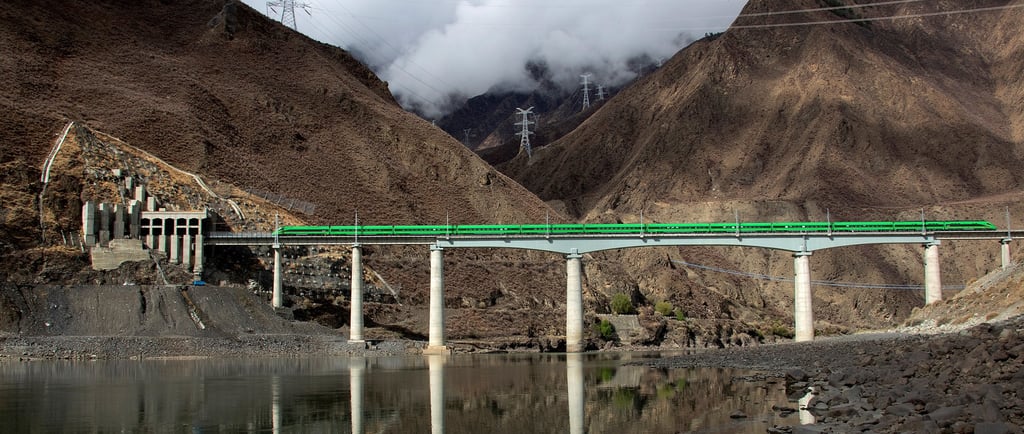China: The Belt and Road Initiative and the Proliferation of Brown Infrastructure
The Belt and Road Initiative (BRI), proposed by President Xi Jinping in 2013, represents a significant global effort to enhance infrastructure, economic development, and cultural ties across multiple continents. As this ambitious endeavour unfolds, what are the implications for businesses and the environment, and how will it shape the future of global trade and development?
CHINA
Raymond Puentes
8/28/20243 min read


On 7 September 2013, President Xi Jinping delivered a speech at Kazakhstan’s Nazarbayev University, where he highlighted the resurgence of the ancient Silk Road, noting that it was “full of new vitality with the rapid development of China’s relations with Asian and European countries.” He proposed that China and its Eurasian partners jointly build a “New Silk Road Economic Belt,” an idea he later expanded upon during a speech at the People’s Representative Council of Indonesia by proposing a 21st-century Maritime Silk Road.
The term Belt and Road Initiative (BRI) suggests two primary routes: a maritime road through the Indian Ocean and a land belt across Central Asia. However, in practice, the BRI represents a vast network of interconnected global projects. These initiatives blend old and new developments, span an extensive geographic area, and aim to bolster infrastructure development, investment, and cultural ties. Approximately 60 countries have expressed interest in participating in the BRI, encompassing more than half the global population and around one-third of global GDP.
Within China, the BRI serves three critical roles. First, it addresses the economic disparity between the inland western regions and the more prosperous provinces along the eastern seaboard. Second, it creates business opportunities for Chinese companies in developing countries. Third, it solidifies Xi Jinping’s position as both the current and future leader of China. BRI projects are strategically designed to reduce the extreme levels of inequality in autonomous regions such as Tibet, which have become increasingly discontented with Beijing’s governance. These projects aim to integrate underdeveloped regions with their wealthier neighbours while simultaneously consolidating the power of China’s President.
On the global stage, China’s goals for the BRI include addressing the “Malacca dilemma,” referring to the vulnerability posed by the narrow strait between the Malay Peninsula and the Indonesian island of Sumatra. This strait is the shortest route from East Asia to Europe, Africa, and the Middle East, but it is a chokepoint that could be strategically compromised. To mitigate this risk, China seeks to develop new land routes for energy and essential resources, thereby reducing dependence on the exposed Malacca Strait and expanding its political and economic influence through infrastructure projects. Additionally, the BRI aims to enhance China’s global standing by positioning it as a key player in international development.
Despite the potential benefits of the Belt and Road Initiative, there are significant long-term risks associated with it, including economic, geopolitical, resource-related, environmental, and climate-related challenges. One of the most pressing concerns is whether the BRI will support or undermine global efforts to combat climate change. If investments are directed towards green, low-carbon initiatives, they could serve as a powerful catalyst for promoting environmentally sustainable and resilient infrastructure, essential for achieving the global Sustainable Development Goals (SDGs) and tackling climate change. However, if investments are primarily focused on carbon-intensive projects, they could lead to substantial carbon lock-in, exacerbating the climate change crisis. Furthermore, the social, environmental, and climate-related impacts of BRI projects will likely be unevenly distributed across different regions, social groups, and timeframes.
A prominent example of this is the construction of coal-based power plants along the BRI, such as the Sahiwal coal power plant in Pakistan. While this project has increased energy capacity and spurred economic development in the area, it has also raised significant environmental concerns. Coal, a high-carbon fuel, contributes to greenhouse gas emissions, air pollution, and long-term carbon lock-in, hindering efforts to address climate change. Additionally, nearby communities may suffer from adverse health effects due to air pollution, illustrating how the negative environmental and social impacts of BRI projects can disproportionately affect certain regions and populations.
For businesses in regions affected by the BRI, these developments present both opportunities and challenges. On one hand, the BRI’s extensive infrastructure projects can stimulate local economies by improving connectivity, reducing transportation costs, and facilitating access to new markets. Businesses, particularly in sectors such as construction, logistics, and manufacturing, may find new opportunities to expand their operations and increase their revenues as a result of enhanced trade routes and improved infrastructure.
Moreover, the influx of Chinese investment can lead to increased demand for local goods and services, creating additional business opportunities in areas such as hospitality, retail, and professional services. Companies that are able to adapt to the changing economic landscape and align themselves with the goals of the BRI may benefit significantly from this initiative.
However, businesses must also navigate a complex set of challenges. The environmental and social risks associated with BRI projects could lead to regulatory changes, increased scrutiny from international organisations, and potential backlash from local communities. Companies involved in BRI-related projects may face reputational risks if they are seen as contributing to environmental degradation or social inequality. Additionally, the reliance on Chinese investment and technology could lead to concerns about over-dependence, and businesses may need to carefully manage their relationships with both Chinese and local stakeholders to avoid potential conflicts.
In summary, while the BRI offers substantial opportunities for business growth and development, it also requires careful consideration of the associated risks. Companies operating in BRI-affected regions must be proactive in addressing environmental, social, and governance (ESG) issues to ensure that their participation in the initiative contributes to sustainable and inclusive growth.


